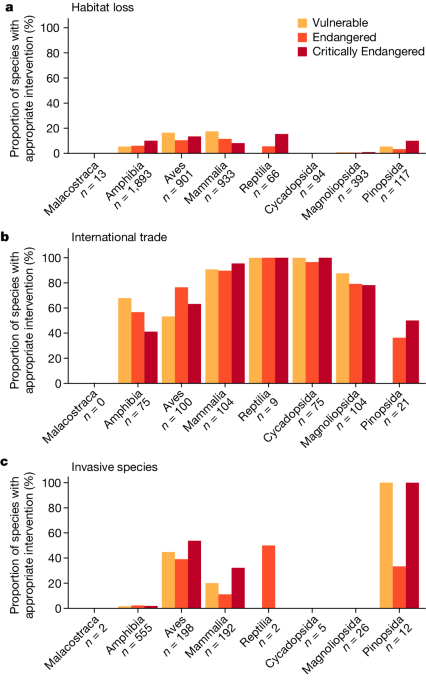insight - Conservation Biology - # Insufficient Conservation Interventions for Threatened Species Worldwide
Widespread Lack of Documented Conservation Efforts for Threatened Species Globally
Core Concepts
Many threatened species lack appropriate conservation interventions, with 91% of them having inadequate habitat representation in protected areas, and 58% lacking sufficient or any documented conservation efforts.
Abstract
The article examines the global state of conservation interventions for threatened species, focusing on the three main drivers of biodiversity loss: habitat loss, overexploitation for international trade, and invasive species. The key findings are:
There is limited understanding of how and where conservation interventions are applied globally, and how effective they are.
91% of threatened species have insufficient representation of their habitats within protected areas.
Conservation interventions are not implemented uniformly across different taxa and regions, and even when present, have infrequently led to substantial improvements in the species' status.
For 58% of the world's threatened terrestrial species, conservation interventions are notably insufficient or absent.
It is unclear whether these species are truly neglected or if their recovery efforts are not included in major conservation databases.
If these species are indeed neglected, the outlook for many of the world's threatened species is grim without more and better targeted conservation action.
Global shortfalls in documented actions to conserve biodiversity - Nature
Stats
91% of threatened species have insufficient representation of their habitats within protected areas.
58% of the world's threatened terrestrial species lack sufficient or any documented conservation interventions.
Quotes
"Threatened species are by definition species that are in need of assistance. In the absence of suitable conservation interventions, they are likely to disappear soon."
"We cannot determine whether such species are truly neglected, or whether efforts to recover them are not included in major conservation databases."
Key Insights Distilled From
by Rebecca A. S... at www.nature.com 06-05-2024
https://www.nature.com/articles/s41586-024-07498-7
Deeper Inquiries
What factors contribute to the uneven implementation of conservation interventions across different taxa and regions?
The uneven implementation of conservation interventions across different taxa and regions can be attributed to several factors. Firstly, funding constraints play a significant role in determining where and how conservation efforts are prioritized. Wealthier regions or species that are more charismatic often receive more attention and resources compared to those in less affluent areas or less visually appealing taxa. Additionally, political priorities and agendas can influence the allocation of conservation resources, leading to disparities in implementation. Lack of data and information on certain species or regions may also contribute to the uneven distribution of conservation interventions, as decision-makers tend to focus on areas where information is readily available. Furthermore, varying levels of capacity and expertise among conservation organizations and governments can impact the effectiveness and extent of interventions, leading to disparities in implementation efforts.
How can the conservation community address the potential issue of neglected threatened species and ensure their recovery efforts are properly documented?
To address the issue of neglected threatened species and ensure their recovery efforts are properly documented, the conservation community can take several proactive steps. Firstly, there needs to be a concerted effort to increase awareness and advocacy for lesser-known or neglected species that are at risk. This can involve targeted campaigns, educational programs, and outreach initiatives to highlight the importance of conserving these species. Collaboration among conservation organizations, governments, and local communities is essential to ensure that all threatened species receive adequate attention and resources for their recovery. Additionally, there should be a focus on improving data collection and monitoring systems to accurately document the status of neglected species and track the effectiveness of conservation interventions. Transparency and accountability in reporting on conservation efforts are crucial to ensure that neglected species are not overlooked and that their recovery is prioritized.
What innovative approaches or technologies could be leveraged to improve the monitoring and evaluation of conservation interventions globally?
Innovative approaches and technologies can play a crucial role in improving the monitoring and evaluation of conservation interventions globally. One such approach is the use of satellite imagery and remote sensing technology to monitor changes in habitat loss, deforestation, and land use patterns in real-time. This can provide valuable data for assessing the impact of conservation interventions and identifying areas that require immediate attention. Additionally, the use of drones and UAVs (Unmanned Aerial Vehicles) can help in conducting aerial surveys and monitoring wildlife populations in remote or inaccessible areas. Incorporating citizen science initiatives and crowdsourcing data collection can also enhance monitoring efforts by engaging the public in conservation activities and expanding the reach of monitoring programs. Furthermore, the adoption of blockchain technology for tracking and verifying conservation actions and funding can improve transparency and accountability in the conservation sector, ensuring that resources are effectively utilized and interventions are properly evaluated.
0
